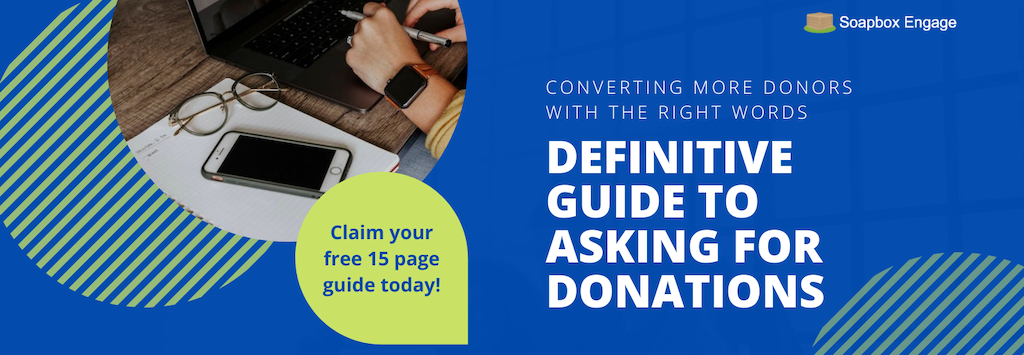
Donation receipts may seem like a task that you don’t want to deal with. They are sometimes thought of as a “necessary evil,” and are required by the IRS. However, their role in tax deductions is not the only purpose they serve. Your donor receipts can serve as another touchpoint to connect with your donors. And that means they’re important for you to pay attention to!
Table of Contents
- What is a donation receipt?
- When do you need to issue a donation receipt?
- What must a donation receipt include?
- Using donation receipts to connect with your donors
What is a donation receipt?
A donation receipt is a written acknowledgment that a donation was made to a nonprofit organization. Providing a receipt lets your donors know that their donation was received. These receipts are written records that acknowledge a gift to an organization with a proper legal status.
These receipts help donors keep track of their finances. And if their donation exceeds $250, and they want to claim a charitable deduction on their taxes, they will need to have a donation receipt.
When do you need to issue a donation receipt?
There are no official rules about how long after a donation is made before you need to issue the receipt. However, if a donor makes a donation, it is important for them to know their donation was received, and also to be thanked. It’s recommended to send out a receipt within 24-48 hours of receiving the donation. You can make this easy by automating donation receipts.
If a donor makes a gift of more than $250, they need a written donation receipt from the nonprofit. Noncash donations under $500 in value also require a receipt. (No receipt is required for noncash donations that are left in an unmanned donation bin, as that would be impractical.) Noncash donations over $500 in value require a donation receipt and a record of how and when your organization acquired the items.
What must a donation receipt include?
If a donation receipt does not include the necessary information, the IRS will not allow it to be claimed as a charitable donation. Also, donation receipts are a way for your donors to keep track of their finances, and for your organization to keep your paperwork in order. You want that to be as clear as possible. A donation receipt should include these things:
- Name of the organization to which the donation has been made
- A statement that the nonprofit is a public charity recognized as tax-exempt by the IRS under Section 501(c)(3)
- Donor’s name
- Date of donation receipt
- Amount of cash contribution
- Description of any noncash contribution
- A statement that no goods or services were provided by the organization (if applicable)
- Description and good faith estimate of the value of goods or services, if any, that the organization provided in return for the contribution
Using Donation Receipts to Connect With Your Donors
You never want to waste an opportunity to further steward your relationship with your donors. A donation receipt can also be a brilliant opportunity to connect!
Make it personal
This is a receipt for your donor making a donation, which is a wonderful thing! So, they should feel similarly wonderful when they receive their receipt. Make your letter thanking them personal. Include their first name when you greet them. If you’re sending an email, put some pep in your subject line. If you’re sending it through snail mail, write a personal message to give it that extra touch.
Make sure to say thank you! The thank you and the receipt should be included in the same place. You don’t want them to be confused by receiving two separate things.
Give them an opportunity to dive deeper
There are lots of different things you can do to make your donor want to dive deeper. Short videos or high-quality photos are a great way to personalize the transactional process of giving a donation. This could also be an opportunity to include testimonials from your staff, volunteers, or beneficiaries, to give them a better picture of the experience of your organization’s work.
Inviting them to dive deeper doesn’t mean inviting them to give more. Stick to a thank you, and give them some opportunity to be more invested in your mission!
Provide an annual summary
An annual summary of donations isn’t required by the IRS, but it could be extraordinarily helpful for your donors as they’re keeping track of their finances. That way they don’t have to keep track of single receipts. It’s best to send summaries in January after you finish processing year-end donations. This small step to make the lives of your donors’ easier is definitely worth it!
Taking these steps will ensure you send donation receipts that everyone is happy with!
Here are three more resources to help with donor engagement:
- 3 Reasons Donors Love Corporate Matching Gift Programs: Corporate matching gift programs are becoming increasingly popular. These are considered mutually beneficial relationships between the giving company and the receiving organization. And they benefit the donor as well! This post shares what is so appealing about corporate matching gift programs for donors.
- How to Write the Perfect Nonprofit Thank You Email: A well-timed, heartfelt thank you email that shares value with your donor and shows appreciation goes a very long way. This blog post guides you through writing the perfect thank you email.
- Turn Your Nonprofit Social Media Followers Into Donors: Social media can be a central part of attracting and retaining current and potential donors. But it’s not simple. You have to understand how to leverage the power of social media to help boost your overall fundraising. This blog post contains wisdom and insight from industry experts to help you convert social media followers to committed financial supporters.
